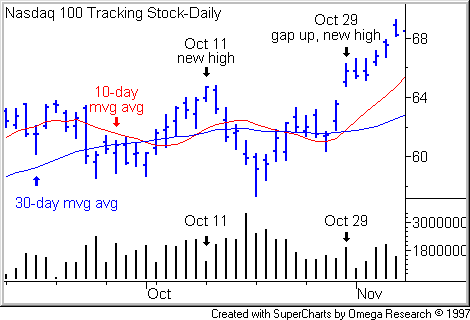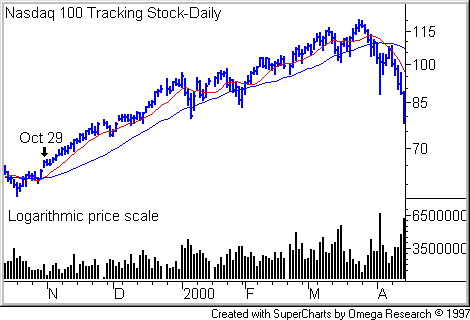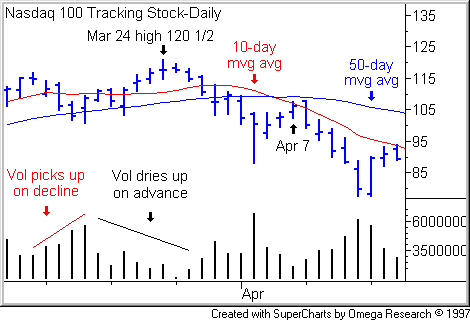Today’s Trading Lesson From TradingMarkets
Editor’s Note:
Each night we feature a different lesson from
TM University. I hope you enjoy and profit from these.
E-mail me if you have
any questions.
Brice
ETF Trading
Tactics, Part 1: Identify ETF Turns Using Moving Average Crossovers
By Loren Fleckenstein
Exchange-traded funds make an ideal weapon for exploiting market turns.
Just buy or short the tradable fund that tracks your chosen market or sector
index.
In this lesson, I’ll teach you the
moving average crossover. Combined with
chart analysis, this indicator can serve as an effective confirmation signal
telling you when a market may have bottomed and reversed to the upside.
Some of you may be new to
exchange-traded funds.
So let me digress for a minute before jumping into the crossover.
Exchange-traded funds offer the
diversification of index mutual funds by spreading your dollar among the stocks
of many different companies. Some ETFs track indexes, others key in on baskets
of stocks that represent narrow industries.
Unlike mutual funds, the ETFs trade on
exchanges (just about all of them presently being listed on the American Stock
Exchange). These “tradable funds” are quoted just like stocks, their bid and ask
prices adjusting throughout the day, in response to supply and demand. This
allows you to take advantage of moves and signals intraday.
Traditional mutual funds price only
once a day. After each market close, the fund houses calculate each fund’s Net
Asset Value in light of the closing prices of their component shares. This
precludes mutual funds from becoming trading vehicles, for most purposes.
For more information on these
securities, click on the Funds tab near the top of this page. Also read
my
tutorial on exchange-traded funds.
Crossovers: 10-day
and 30-day moving averages
A moving average crossover occurs when
a faster (shorter) moving average traverses a slower (longer) moving average.
This can alert you to an important change in trend. I find that simple 10- and
30-day moving averages work well for intermediate-term trading.
However, the
moving-average crossover does not constitute a complete signaling system by
itself. Used this way, you’ll enter many trades only to get stopped
out, eroding the returns of your positive trades to a much higher degree than
necessary.
You should use the crossover with
other evidence — namely price breakouts and
volume — to help
confirm a significant trend change.
I regard volume as especially
important with crossovers. The action of any moving average, of course, is
affected by price. So a price breakout, while bullish, so some degree will be
reflected in the stock’s moving averages. Volume, however, constitutes an
independent variable.
Let me show you an example.
The following chart shows the Nasdaq
100 Tracking Stock (QQQ)
from September to November 1999. The Cubes,
as they are popularly called, are exchange-traded fund shares created to
correlate tightly with the Nasdaq 100 Index ($NDX.X).
This index consists of the 100 biggest non-financial Nasdaq stocks by market
capitalization.

As you can see, the fund’s 10-day
moving average, in red, crossed above the 30-day MA, in blue, on Oct. 11, 1999.
This coincided with the Cubes making a new high. New highs tend to be bullish.
But notice how volume dried up at the
same time. That tells me that the market wasn’t quite ready to believe that the
new high spelled a fresh advance.
The rally promptly stalled, the Cubes
headed lower, and the 10-day bearishly undercut the 30-day.
Then on Oct. 28-29, the market rallied
again. On Oct. 29, volume surged, a sign that institutional money was piling
back in. Bingo!
The same day, the Cubes not only made
a fresh new high, they gapped up to the
record level, more evidence of conviction.
Meanwhile, the 10-day moving average
crossed above the 30-day MA, portending a trend change. It was all there: new
high, strong volume and crossover, plus the add icing of a gap-up price move.
That’s about as clear a buy signal as
you’re likely to get! The Nasdaq 100 and its tracking stock had just broken out
of a sideways trading range into a new uptrend.
Here’s a slightly closer look at the
same series of events.

A Resilient Trend
Once you use a short average crossover
to lead a trend, you can also use it to test the same trend. In this case, once
the 10-day rose above the 30-day, the shorter average continued to lead the
longer one through the peak in the Nasdaq 100 on March 24.

When the 10-day finally rolled beneath
the 30-day on April 7, the bear market had begun for the Cubes, which peaked at
120 1/2 on March 24.
Now obviously, I would want to get out
earlier than April 7. But don’t expect to call market tops right at the peak.
The key is to get out with your profit intact. Don’t beat yourself up if you
escaped a bit early or a bit late.
As we know in this market top, leading
stocks went into breakdowns ahead of Nasdaq 100 peak. Just watching the Cubes,
you would have seen an ominous dry-up of volume going into the rally that took
the tradable fund to the March 24 high. Again, I prefer to use the moving
average crossover as a confirmation signal. There’s no escaping reliance on your
own judgment.

Jim Whitner, managing director of Glenwood Equity Investors, suggests this
rule of thumb for traders caught between deciding how much play to give the
market before stopping out. At the helm of the Stargazer One hedge fund, Whitner
returned 170% in 1999.
“If you’ve got a huge profit in your
position, you may wait for the 10-day to cross below the 30-day to confirm a
change in the dominant trend and tell you to sell,” Whitner said. “But if you
have small profit, and you’re trying to avoid a big loss, you may want to sell
if the index crosses below the 10-day moving average.
“The more sensitive your tolerance to
risk, the more sensitive your indicator. It’s an inexact science, but it works
for playing the big trends. Just adapt the indicators for your risk-management
strategy.”
In short, trading these trends not
about being precisely right. It’s about getting in soon enough and exiting soon
enough to make money.
